Most visitors to Canada wanting to plan a “winter national park vacation” will tend to focus their attention on Banff National Park in Alberta with its world-class ski resorts, accommodations, and dining. Meanwhile, neighboring Yoho National Park in British Columbia is highly overlooked, even though its winter scenery certainly rivals other Rocky Mountain National Parks in Canada.
Where Yoho National Park may seem quiet and “off the beaten path,” it more than compensates with backcountry ski and snowshoe trails, rustic lodges, and pristine powder. It’s perfect for exploring the wilderness, away from the crowds of tourists in other parks.
Here we highlight two main areas (Emerald Lake and Lake O’Hara) within Yoho National Park and provide trails, accommodations, and other suggestions to check out.
About Yoho National Park
Yoho National Park is located in the province of British Columbia and is accessed via a short 10-minute drive from Lake Louise (also an excellent winter destination) in neighboring Alberta or the town of Golden on the other side of the park.
The small town of Field is the “hub” for the park and offers simple accommodations in guest houses, hostels, or B&Bs. Or, the nearby Emerald Lake Lodge offers lakeside accommodations with gourmet dining and trails on site for skiing or hiking.
International visitors can fly into Calgary and drive out to Field in a 2.5-hour drive (129 miles.) Driving from Calgary will also allow you to spend time in Banff and Lake Louise on your drive out or your return trip.
Read More: A Winter Explorer’s Guide to the Best of Banff National Park
Emerald Lake
Emerald Lake is a popular destination for both day and overnight trips, with trails for snowshoeing and skiing. You’ll also find apres and accommodation for all your needs.
Emerald Lake Loop
Visitors to Emerald Lake will want to start with a hike around the lake on the 3.3-mile (5.3 km) Emerald Lake Loop.
It’s easiest to hike straight across the lake until you reach the far side (as long as it is well-frozen with ice at least 4in/10cm thick). Then, you can join the summer hiking trail for the remainder of the trip, completing your loop in a clockwise direction. But, if you tire of hiking through the trees at any point on your way back, you can easily hop back onto the lake and head back to where you started.
Read More: Safety First: Snowshoeing Hazards and How To Avoid Them
Alluvial Fan Loop
If you choose to ski, you can continue past Emerald Lake onto the easy Alluvial Fan Loop (2.7 miles/ 4.3 km). This loop is one of the most beautiful trails I’ve ever skied in the Canadian Rockies.
Note that this is a “ski-specific trail,” so if you choose to snowshoe it, please respect the ski trail and stay well to the side of all tracks. The same should be said for snowshoeing across the lake or at the back of the lake when you will be paralleling the ski trail.
Snowshoe and ski rentals are available at the lake.
Read More: Trail Etiquette for Snowshoeing and Winter Hiking
Hamilton Falls Trail
Another beautiful trail at Emerald Lake is the Hamilton Falls Trail. This trail is approximately 1 mile (1.6 km) return with a small amount of elevation gain.
We chose to hike the trail without snowshoes because it was well-packed. Plus, the climb up to the falls was easier without snowshoes on our feet.
I wasn’t expecting much from the falls but was pleasantly surprised by these small waterfalls. They are now on my annual winter ice-chasing list, and the hike was a lot of fun as a family.
Read More: How To Choose a Trail: Tips for Learning When You Need Snowshoes
Emerald Lake’s Natural Bridge
You’ll see a small pullout with a sign for the Natural Bridge as you drive up the road from the TransCanada Hwy to Emerald Lake. We’d never stopped here before. So we decided to finally see what all the fuss was about on a recent visit. I was utterly blown away and surprised by how amazing this “tourist site” is in winter.
The Emerald River was frozen, so we could descend to the river. We walked under the pedestrian summer bridge you’d typically use to view the natural bridge. Moreover, we even got to walk under the natural bridge, which was surreal and definitely on our “must-do again” list for future trips.
Read More: Frozen Waterfalls and Ice Walks in Banff National Park
Emerald Lake Lodge
If staying overnight, lodging is available at the luxurious Emerald Lake Lodge. Visitors to Emerald Lake Lodge enjoy skiing or hike-in/out lakeside cabins at a front country lodge you can access by vehicle. Think “backcountry lodge” that you can drive to.
Once you arrive at the lodge, you’ll feel as if you had travelled back to an era when families planned winter ski vacations to the grand lodges of the Canadian Rockies, arriving by train or even wagon in the early days. According to the Emerald Lodge archives, the trip from Field took two hours, with a stop to enjoy the natural bridge. By comparison, driving from Field to Emerald Lake Lodge takes less than half an hour today.
I still find the “character” of the lodge has not changed much since it was built in 1902. I appreciate that cars must park below the lodge, keeping the pathways clear for guests to walk between their rooms and the main lodge. The only “wheels” you’ll see rolling around the property belong to the shuttle bus dropping visitors off at the main lodge.
Beyond the main lodge building, access to all guest rooms is on foot unless you’ve requested a ride with your luggage with the bell boys in one of their small carts.
The Apres Experience at the Lodge
The main lodge building is home to a gourmet restaurant. Here, you can feast on local Rocky Mountain cuisine that rivals the menus at any decadent restaurant in Banff or Lake Louise. There’s also a casual lounge where you can order snacks and drinks while warming up by the fireplace after hiking around the lake. I could spend an entire weekend sitting by the fireplace, playing games, and drinking coffee.
So, whether you’re staying at Emerald Lake Lodge or down in the town of Field, I recommend making a reservation at the lodge for dinner one night. Or you can stop in at the lounge after your day hike at the lake or pop in for a weekend brunch. The brunch buffet is amazing, and my child is a huge fan of their cinnamon pancakes.
Read More: Snowshoeing Paradise at Canada’s Emerald Lake Lodge
Lake O’Hara
Where Emerald Lake offers a softer “front country” winter experience, Lake O’Hara counters with an off-the-grid backcountry experience to give you the whole Rocky Mountain package.
In addition to the access road and apres options, the Alpine Club offers some trails to check out near Lake O’Hara.
Access Road to Lake O-Hara
Between June and October, a shuttle (advanced reservations required) can take you to Lake O’Hara. But in the winter, there is only one way to reach the world famous. The way is on foot via a one-way 6.8-mile (11 km) ski or hike.
Cross-country skiers can easily make the round-trip distance to O’Hara in a day. Moreover, you can even stop in at the Lake O’Hara Lodge for lunch if they get an early start.
On the other hand, snowshoers and hikers will likely want to spend the night at either the lodge or the alpine club hut at the lake. Unfortunately, both are challenging to get reservations at, so you’ll want to plan at least your overnight trip to O’Hara a year in advance.
Read More: 5 Getaways for Snowy Spring Fun in the Canadian Rockies
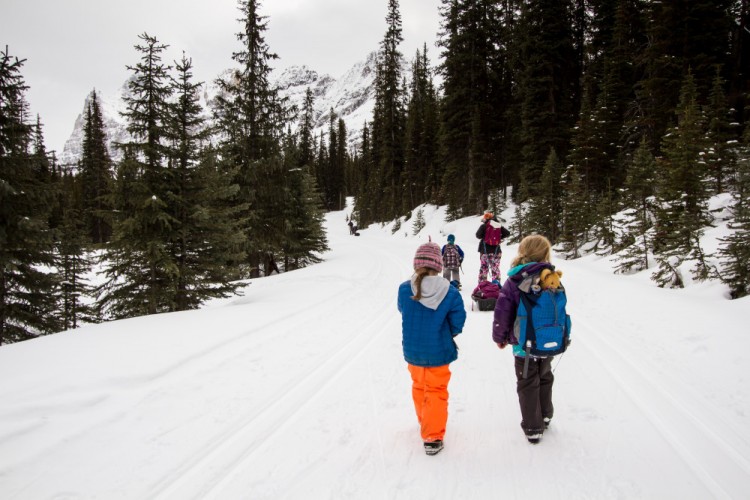
The hike into Lake O’Hara is 11 km, but staying at the Lake O’Hara Lodge or Elizabeth Parker Hut can make the trip more manageable for snowshoers. Photo: Megan Dunn
Lake O’Hara Lodge
I’ve skied into Lake O’Hara many times for the day, and I always like to visit the Lake O’Hara Lodge for lunch and a chance to warm up.
The lodge welcomes non-registered guests to visit on weekends during their operational season for a light lunch of soup, salad, dessert, coffee, or tea. Lunch seating is open from 12 to 1:30 pm, and no reservations are required. Note that payment is with cash only. I also highly recommend checking their website to ensure the lodge is open before making the long ski-in with no lunch in your backpack. (And yes, I learned that the hard way one year!)
Staying at the Lake O’Hara Lodge can be fairly expensive. For those that can finance the trip, though, know that you’ll remember it for the rest of your life. I had the amazing opportunity to stay at the lodge last winter.
Read More: Winter at the Lake O’Hara Lodge: The Ultimate Canadian Rocky Mountain Lodge
Elizabeth Parker Hut
Try reserving the Elizabeth Parker Hut for a more budget-friendly visit to Lake O’Hara. The Alpine Club of Canada maintains this small backcountry hut a short distance away from Lake O’Hara.
Here, you can stay at this cozy facility, which sleeps 20 people in winter. You’ll have to bring your sleeping bag and food, but cooking facilities, supplies, and dishes are provided.
We spent Easter at the Elizabeth Parker Hut. We booked most of the hut a year in advance to share with a great group of families. Also, we skied in but brought snowshoes with us to tour the Lake O’Hara area while at the hut.
Read More: 10 Snowshoe Adventures To Try This Winter in the Canadian Rockies
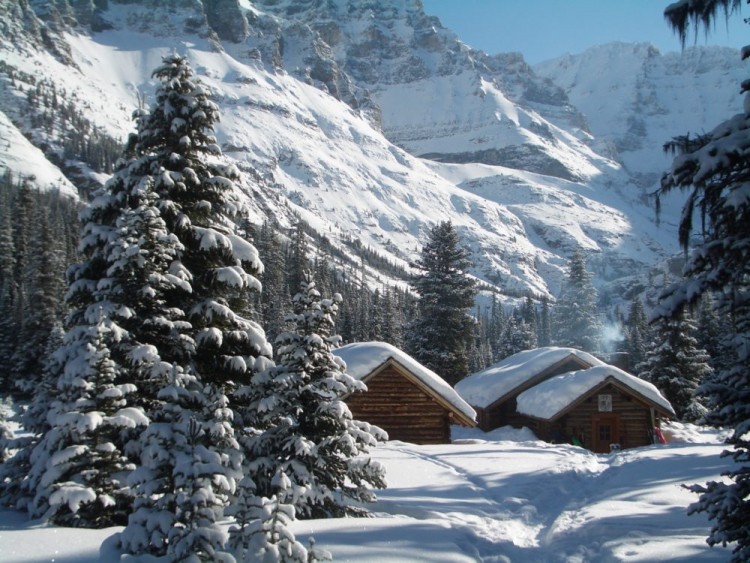
Try a cozy stay at the Elizabeth Parker Hut in winter for your journey to Lake O’Hara. Photo: Tanya Koob
Other Yoho Winter Trails
In addition to Emerald Lake and Lake O’Hara, here are a few other winter trails to check out in Yoho National Park.
Wapta Falls
Wapta Falls offers an easy 9.6 km/ 5.7-mile round-trip hike or ski to a beautiful set of frozen waterfalls. The first part of the trail follows a summer road, making it ideal for skiing. But, then, the trail becomes narrower and is easiest on snowshoes.
Read More: Top Winter Hiking Trails in the Canadian Rockies
Sherbrooke Lake
Sherbrooke Lake is an intermediate 6.2 km/ 3.8-mile round-trip hike to a beautiful backcountry lake. This hike is also popular with backcountry skiers.
It is not recommended to continue to the far end of the lake, or you will be in avalanche terrain.
Read More: Why All Snowshoers Should Be Avalanche Aware (Even Beginners)
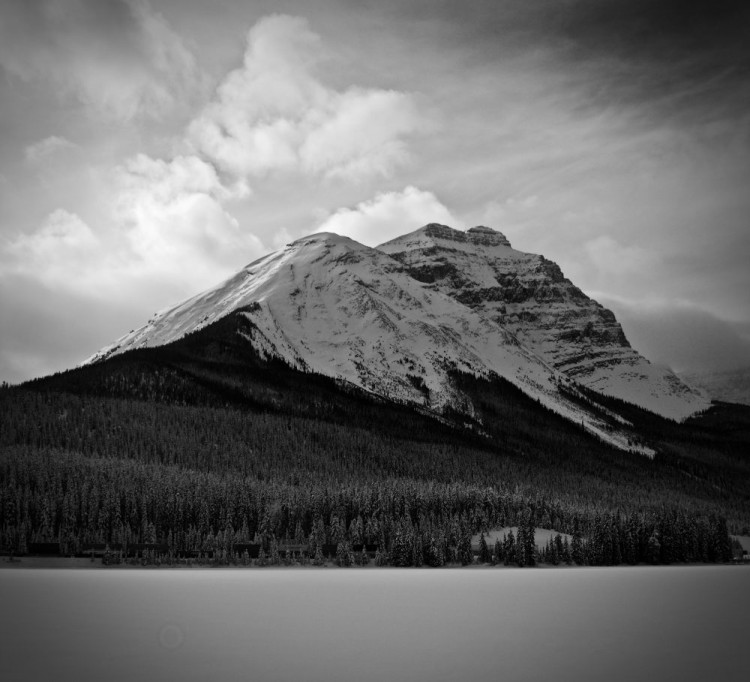
If looking for an intermediate outing, try Sherbrooke Lake in Yoho National Park. Photo: Sherry Hart
Ross Lake Circuit
Ross Lake is an intermediate 6.4 km/4mi circuit that uses a portion of the Lake O’Hara Road and the Great Divide ski trail.
This trail is popular with backcountry skiers. So, be prepared to quickly jump off the route if snowshoeing should you encounter a skier coming down a hill quickly towards you.
Read More: Slide Into Backcountry Snowboarding on Snowshoes
Additional Resources
Parks Canada publishes a great winter guide to Yoho National Park. You can download it for more information on hiking and skiing trails in this area.
Furthermore, purchase your Discovery Pass to access over 80 of Canada’s Parks.
The author received complimentary accommodations at Emerald Lake Lodge and the Lake O’Hara Lodge to gather content for this and other stories. As always, all opinions and words are my own. This article was originally published on February 19, 2017, and most recently updated on February 23, 2023.
Read Next: Winter Activity Guide to the Best of Lake Louise, Banff National Park

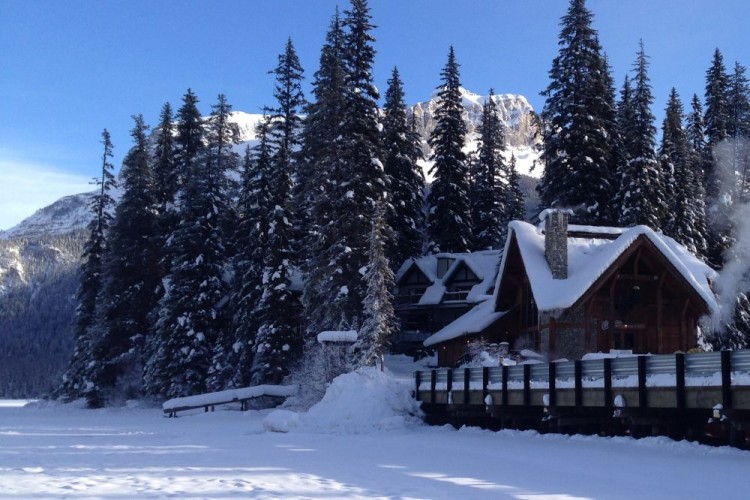
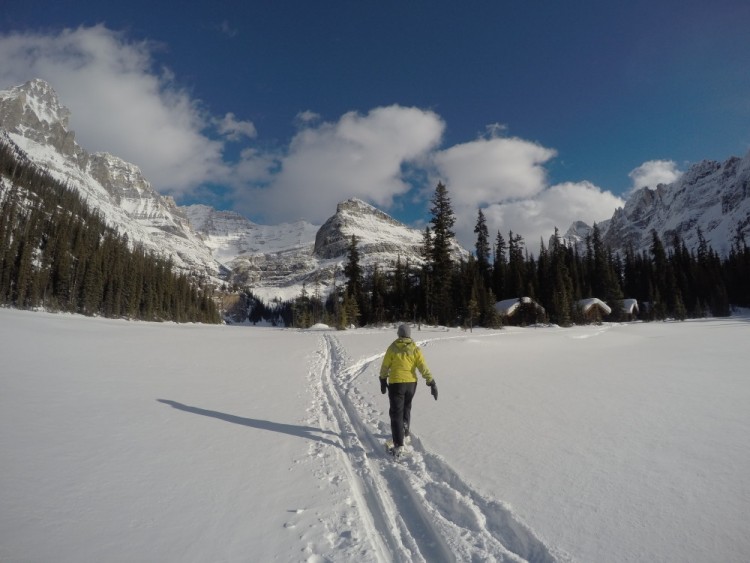
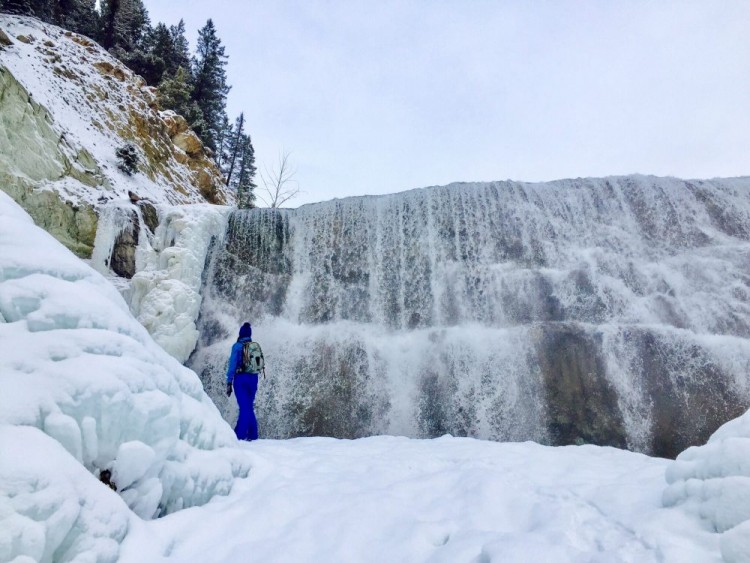
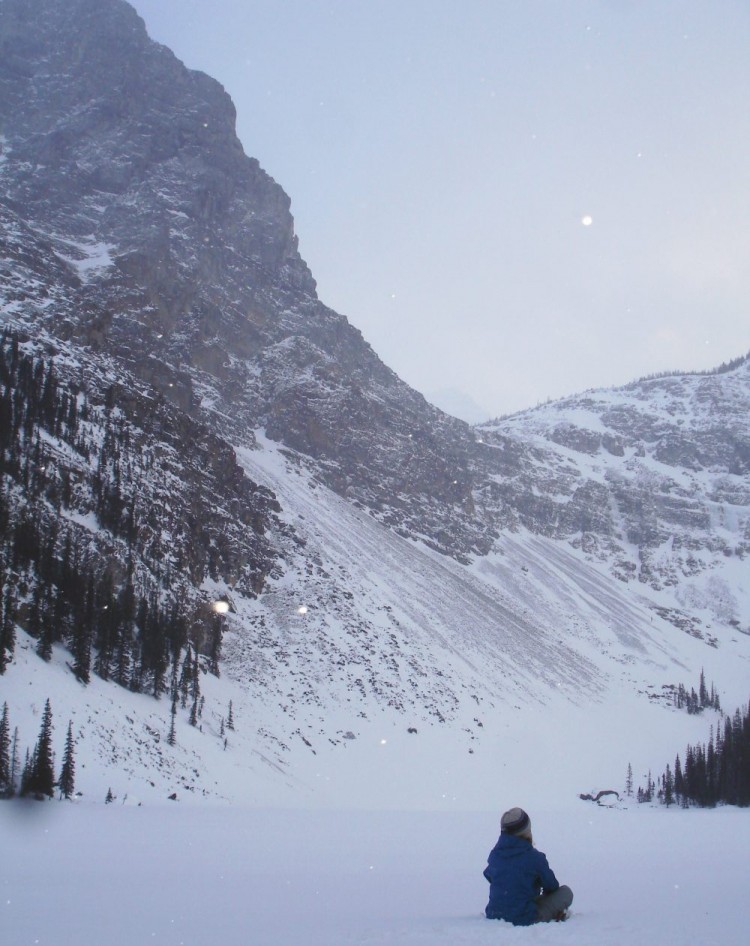
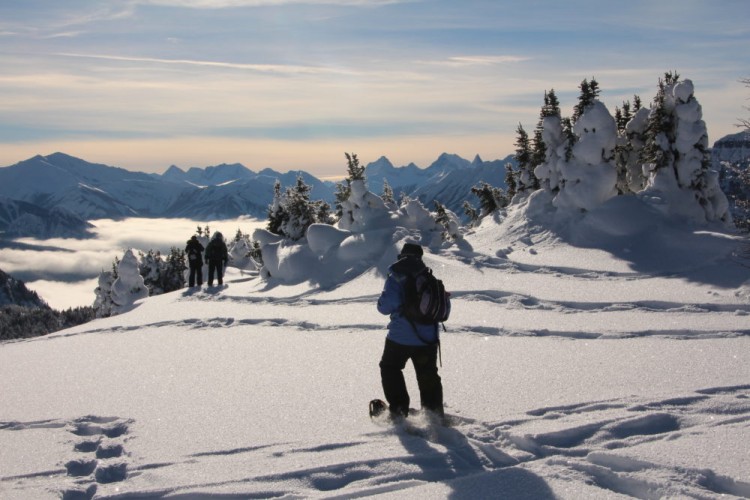
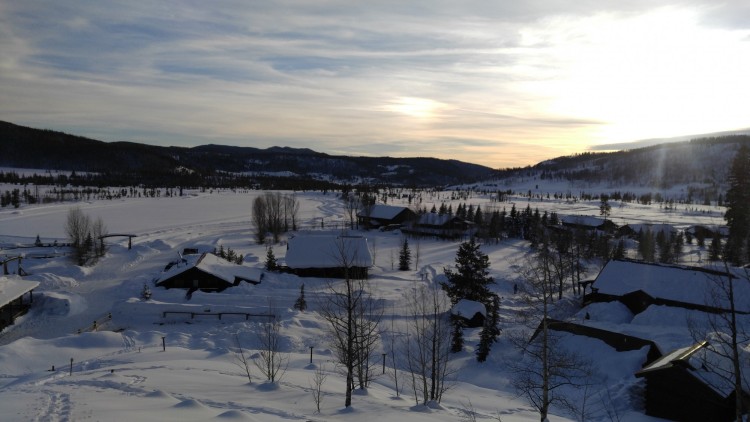

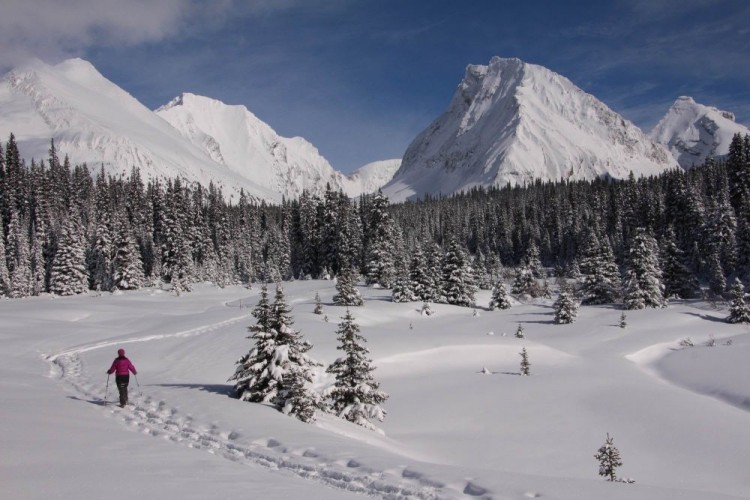

Leave a Comment